Monthly Archives: May 2018
 My sister-in-law, Brenda Schulenberg became quite ill a number of years ago, and finally had to face the fact that her weight was slowly killing her. I suppose some people might think that statement is harsh, but they don’t know my sister-in-law. Those were fighting words for her, or at least a call to action. When she found out that her weight had caused sleep apnea and congestive heart failure, she decided that she was not going to let her weight win. From that day forward, the world would see a new Brenda…a determined Brenda.
My sister-in-law, Brenda Schulenberg became quite ill a number of years ago, and finally had to face the fact that her weight was slowly killing her. I suppose some people might think that statement is harsh, but they don’t know my sister-in-law. Those were fighting words for her, or at least a call to action. When she found out that her weight had caused sleep apnea and congestive heart failure, she decided that she was not going to let her weight win. From that day forward, the world would see a new Brenda…a determined Brenda.
The road was long, and filled with hard work. Brenda doggedly walked in the cold early morning hours, rain or shine, and even in snow. She bought a bicycle, and fought hard  to master that skill again, even with knees that had to be retrained to bent enough to work the pedals. In fact, when she started, Brenda had to take the pedals off and strider the bike (basically run while seated on a bicycle). It was work, but she wanted to ride a bicycle again, and determination goes a long way toward success. These days Brenda can be found riding her bicycle most days at some point in the day. She loves the Platte River Trail, and often rides its entire length.
to master that skill again, even with knees that had to be retrained to bent enough to work the pedals. In fact, when she started, Brenda had to take the pedals off and strider the bike (basically run while seated on a bicycle). It was work, but she wanted to ride a bicycle again, and determination goes a long way toward success. These days Brenda can be found riding her bicycle most days at some point in the day. She loves the Platte River Trail, and often rides its entire length.
Not only has Brenda continued to follow her own health and fitness plan, but she has chosen to mentor others. She has made several trips to attend meetings in other towns to talk to their weight loss groups, even if they are not on Weight Watchers, like  she is. She has put her name out there as someone who will buddy up with people who are struggling to lose weight to see if she can be on any encouragement or assistance. She is willing to go out and walk with them or ride bicycles with them too. She is so adamant about health, that she doesn’t want anyone to struggle with their health. I guess that since she has been on the unhealthy side of life, and the healthy side of life, and has chosen the healthy side of life, she wants others to be able to experience just how great it feels to be healthy…and she wants to help them to achieve their own health and fitness goals that have seemed so impossible to them. It is a noble calling. Today is Brenda’s birthday. Happy birthday Brenda!! Have a great day!! We love you!!
she is. She has put her name out there as someone who will buddy up with people who are struggling to lose weight to see if she can be on any encouragement or assistance. She is willing to go out and walk with them or ride bicycles with them too. She is so adamant about health, that she doesn’t want anyone to struggle with their health. I guess that since she has been on the unhealthy side of life, and the healthy side of life, and has chosen the healthy side of life, she wants others to be able to experience just how great it feels to be healthy…and she wants to help them to achieve their own health and fitness goals that have seemed so impossible to them. It is a noble calling. Today is Brenda’s birthday. Happy birthday Brenda!! Have a great day!! We love you!!
 As automobiles became commonplace…or at least more so than they had been, people began to realize that there needed to be some controls on their usage…specially in the area of speed. Most people know that is a car or other vehicle can go fast, there will always be someone out there, who wants to push the envelope and see just how fast it will go, throwing caution to the wind. With increased speeds would also follow, increased numbers of accidents. There would need to be some rules to follow.
As automobiles became commonplace…or at least more so than they had been, people began to realize that there needed to be some controls on their usage…specially in the area of speed. Most people know that is a car or other vehicle can go fast, there will always be someone out there, who wants to push the envelope and see just how fast it will go, throwing caution to the wind. With increased speeds would also follow, increased numbers of accidents. There would need to be some rules to follow.
There were already speed limits in the United States for non-motorized vehicles. In 1652, the colony of New Amsterdam, which is now New York, issued a decree stating that “[N]o wagons, carts or sleighs shall be run, rode or driven at a gallop” at the risk of incurring a fine starting at “two pounds Flemish,” or about $150 in today’s currency. In 1899, the New York City cabdriver Jacob German was arrested for driving his electric taxi at 12 miles per hour, but did the prior law really apply electric cars? It was becoming more and more obvious that some sort of legislation was necessary to ensure the safety of those operating these new machines, and those around them. So began the path to Connecticut’s 1901 speed limit legislation. Representative Robert Woodruff submitted a  bill to the State General Assembly proposing a motor-vehicles speed limit of 8 miles per hour within city limits and 12 miles per hour outside. While the law passed in May of 1901 specified higher speed limits, it required drivers to slow down upon approaching or passing horse-drawn vehicles, and come to a complete stop if necessary to avoid scaring the animals. I can’t imagine some of the restrictions listed there, because people would be stopped more than they were driving, but you have to start somewhere, and Connecticut was that starting point, when, on May 21, 1901 it became the first state to pass a law regulating motor vehicles, limiting their speed to 12 miles per hour in cities and 15 miles per hour on country roads.
bill to the State General Assembly proposing a motor-vehicles speed limit of 8 miles per hour within city limits and 12 miles per hour outside. While the law passed in May of 1901 specified higher speed limits, it required drivers to slow down upon approaching or passing horse-drawn vehicles, and come to a complete stop if necessary to avoid scaring the animals. I can’t imagine some of the restrictions listed there, because people would be stopped more than they were driving, but you have to start somewhere, and Connecticut was that starting point, when, on May 21, 1901 it became the first state to pass a law regulating motor vehicles, limiting their speed to 12 miles per hour in cities and 15 miles per hour on country roads.
Immediately following this landmark legislation, New York City went to work to keep up, and introduced the world’s first comprehensive traffic code in 1903. Adoption of speed regulations and other traffic codes was a slow and uneven process across the nation, however. As late as 1930, a dozen states had no speed limit, while 28 states did not even require a driver’s license to operate a motor vehicle. Rising fuel prices contributed to the lowering of speed limits in several states in the early 1970s, and in January 1974 President Richard Nixon  signed a national speed limit of 55 miles per hour into law. These measures led to a welcome reduction in the nation’s traffic fatality rate, which dropped from 4.28 per million miles of travel in 1972 to 3.33 in 1974 and a low of 2.73 in 1983.
signed a national speed limit of 55 miles per hour into law. These measures led to a welcome reduction in the nation’s traffic fatality rate, which dropped from 4.28 per million miles of travel in 1972 to 3.33 in 1974 and a low of 2.73 in 1983.
Concerns about fuel availability and cost later subsided, and in 1987 Congress allowed states to increase speed limits on rural interstates to 65 mph. The National Highway System Designation Act of 1995 repealed the maximum speed limit. This returned control of setting speed limits to the states, many of which soon raised the limits to 70 mph and higher on a portion of their roads, including rural and urban interstates and limited access roads.
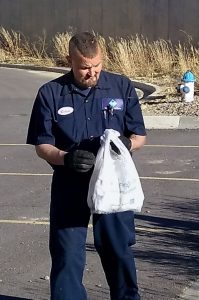 My nephew, Rob Masterson has been working at Sam’s Club in the Tire and Battery Center since August 1, 2017. Rob had not been able to work for some time, due to health issues brought on by his time in the service. The VA really wasn’t helpful to him, and after 4 plus years of waiting for them to decide on disability status, he’d had enough. Rob and his wife, Dustie were both unhappy with their current situation. Her job was not fulfilling, and they took her for granted. Then, Rob and Dustie basically stumbled on their jobs, and they will tell you that it was the best kind of accident to have. They were shopping at Sam’s club when they saw that Sam’s was hiring. They filled out the online application, and first Rob was called, and then Dustie. They were so excited to find that they would both be working at the same place. As Dustie puts it, “It’s amazing being able to work with your best friend. You know all the same people at work for the most part, and even though most people might find it weird to be able to discuss work and both know exactly what the other does, for us it’s just natural.” They did their orientation together, and both started on August 1, 2017. Rob actually started working before he completed the orientation, because his boss came in and said, “I need you now!” He would have to complete his orientation later. Rob, who has Rheumatoid Arthritis, was a little nervous about how his knees were going to handle the work, but he says that it hasn’t been too bad. Rob and Dustie prayed about his knees and ask for strength to be able to handle the work, and God answered their prayers.
My nephew, Rob Masterson has been working at Sam’s Club in the Tire and Battery Center since August 1, 2017. Rob had not been able to work for some time, due to health issues brought on by his time in the service. The VA really wasn’t helpful to him, and after 4 plus years of waiting for them to decide on disability status, he’d had enough. Rob and his wife, Dustie were both unhappy with their current situation. Her job was not fulfilling, and they took her for granted. Then, Rob and Dustie basically stumbled on their jobs, and they will tell you that it was the best kind of accident to have. They were shopping at Sam’s club when they saw that Sam’s was hiring. They filled out the online application, and first Rob was called, and then Dustie. They were so excited to find that they would both be working at the same place. As Dustie puts it, “It’s amazing being able to work with your best friend. You know all the same people at work for the most part, and even though most people might find it weird to be able to discuss work and both know exactly what the other does, for us it’s just natural.” They did their orientation together, and both started on August 1, 2017. Rob actually started working before he completed the orientation, because his boss came in and said, “I need you now!” He would have to complete his orientation later. Rob, who has Rheumatoid Arthritis, was a little nervous about how his knees were going to handle the work, but he says that it hasn’t been too bad. Rob and Dustie prayed about his knees and ask for strength to be able to handle the work, and God answered their prayers.
He applied for one transfer within the store, but didn’t get it and Dustie says, “I’m glad. When the position opened up to be the team lead over Tire Battery Center, I knew it was a perfect one for him.” I think they didn’t give him the first position, because they knew he was a great asset to the Tire and Battery Center, and they didn’t want to lose him. In the short time that Rob has worked at Sam’s, he has proven his worth. Dustie says that Rob is so nervous about being a supervisor again, but what he doesn’t realize that he is doing a great job. The people that he works with and the people that work for him have nothing but respect for him, and vice 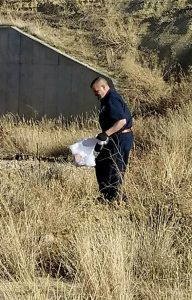 versa. He treats everyone equally and with respect. You can see that he is so much happier…though more tired now, but she doesn’t think he will give it up…ever. He takes pride in his work and it shows. From sweeping the floor and taking out the trash to making sure the tires are correct in size and mounted properly. I think that Rob has always loved tinkering on cars, and so this was right up his alley.
versa. He treats everyone equally and with respect. You can see that he is so much happier…though more tired now, but she doesn’t think he will give it up…ever. He takes pride in his work and it shows. From sweeping the floor and taking out the trash to making sure the tires are correct in size and mounted properly. I think that Rob has always loved tinkering on cars, and so this was right up his alley.
Rob even has his special clients…the ones who ask for him, and who don’t want anyone else to work on their vehicle. One of them is a cute older woman who will not allow anyone else to work on her car, but Rob. Apparently her husband just recently passed away and he was the one who took care of everything on the car for her. When Rob helped her with her car, she was so relieved that someone truly cared, that she teared up. Dustie says, “I couldn’t be more proud of my husband. He is such a wonderful man and he’s making a lasting impression on this Earth and in Heaven. I couldn’t agree more. Today is Rob’s birthday. Happy birthday Rob!! Have a great day!! We love you!!
 My sister, Caryl Reed’s life has changed quite a bit over the last year, as she went from being a full-time respiratory therapist, to being a retired woman, who helps manage the rental business she and her husband, Mike have. Retirement looks good on Caryl. She is relaxed and enjoying the freedom her retirement has brought her. She has more time to spend with her grandchildren, Jaydn and Topher, and to plan the work that is coming up on their retirement ranch outside of Casper. The work on the ranch will be much easier when they don’t have to work things around her schedule, which included weekends, while Mike’s job doesn’t. Mike will be retiring in about five years and then they can move to Casper permanently…which is something we will all be happy about.
My sister, Caryl Reed’s life has changed quite a bit over the last year, as she went from being a full-time respiratory therapist, to being a retired woman, who helps manage the rental business she and her husband, Mike have. Retirement looks good on Caryl. She is relaxed and enjoying the freedom her retirement has brought her. She has more time to spend with her grandchildren, Jaydn and Topher, and to plan the work that is coming up on their retirement ranch outside of Casper. The work on the ranch will be much easier when they don’t have to work things around her schedule, which included weekends, while Mike’s job doesn’t. Mike will be retiring in about five years and then they can move to Casper permanently…which is something we will all be happy about.

As a young girl and into her adulthood, Caryl has loved horses, even taking riding lessons as a way to get her “Horse Fix” on. Having the ranch has given them the ability to have horses around them all the time. They board horses for people who do not have a place to keep their horses. They are always working on ways to improve the places for the horses to run, sleep, and be ridden. Their ranch is going to be great when they get the house built. Right now they have a garage, with an apartment on top, and a trophy room below for Mike’s hunting trophies. Caryl and Mike are designing their new home with all the 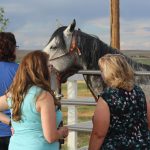 characteristics they like best.
characteristics they like best.
All this is a far cry from the little girl Caryl was. Her ticklish, giggling ways always made her the prime target for the “Tickle Torture” attacks that we, her sister very much loved to inflict upon her. I suppose there are people who might think we were mean to torture Caryl in such a way, but if you were ever a part of something like that, you would know that to attack someone as ticklish as Caryl is…well, it’s totally irresistible. In fact, having her back in Casper might be a really good thing for her torturers. Time will tell, I guess. Today is Caryl’s birthday. Happy birthday Caryl!! Have a great day!! We love you…really, we do!!
 With the eruption and possible explosion of the Kilauea volcano in Hawaii, my thoughts are drawn back 38 years to another mountain…Mount Saint Helens. The scientists said that an explosive eruption was imminent. The mountain had been swelling up with internal pressure from the gasses deep in the earth. Still, some people didn’t believe the mountain would ever hurt them, and many just couldn’t wrap their head around the possibility that it might explode. So, some people stayed in their homes in the area. It would prove to be a fatal mistake.
With the eruption and possible explosion of the Kilauea volcano in Hawaii, my thoughts are drawn back 38 years to another mountain…Mount Saint Helens. The scientists said that an explosive eruption was imminent. The mountain had been swelling up with internal pressure from the gasses deep in the earth. Still, some people didn’t believe the mountain would ever hurt them, and many just couldn’t wrap their head around the possibility that it might explode. So, some people stayed in their homes in the area. It would prove to be a fatal mistake.
It’s strange that we are able to associate things in life with major events in recent history. Many of us can say where we were when we learned of President Kennedy’s assassination, or when 9-11 took place. It is a moment that is embedded in our memories for all time. That morning as the ash rolled into our area, I was getting into my car to go to town. It looked like dust on my car, a very thick layer of dust. Of course, it wasn’t dust, it was volcanic  ash. It had never occurred to me that volcanic ash might affect me, but here I was, needing to wash the ash off of my car, so it was not damaged.
ash. It had never occurred to me that volcanic ash might affect me, but here I was, needing to wash the ash off of my car, so it was not damaged.
My cousin, Shirley, who lives in Washington, said she and her family were in Spokane. She saw a black cloud coming their way, and so she turned on the radio, to see what was going on. She immediately started yelling to the teachers and students from Saint Matthews school, who were at an end of the year baseball game. Every one scrambled to get their belongings, and headed back to the Church, before heading for home. Navigation became difficult. They had to watch the curb on the side of the streets to know where they were. It was a long drive home. They held their breath from the truck to the house, to protect their lungs, and watched the street lights come on. Shirley went out on the front porch and took pictures,  before retreating back to the safety of her house. They were forced to stay in the house for about a week, before it was safe to out again. Many safety precautions were in place, and people were told not to breathe the ash because of the glass in it.
before retreating back to the safety of her house. They were forced to stay in the house for about a week, before it was safe to out again. Many safety precautions were in place, and people were told not to breathe the ash because of the glass in it.
Mount Saint Helens is located in the Cascade Range. On May 18, 1980, at 8:32am Pacific Standard Time, it erupted and blasted 1,300 feet off of its top, sending hot mud, gas, and ash running down its slopes. Approximately 57 people were killed directly from the blast, while 200 houses, 47 bridges, 15 miles of railways, and 185 miles of highway were destroyed. Two people were killed indirectly in accidents that resulted from poor visibility, and two more suffered fatal heart attacks from shoveling ash. The explosion sent plumes of dark gray ash some 60,000 feet in the air which blocked out the rays from the sun making it seem like night over eastern Washington. So…where were you when Mount Saint Helens blew?

 Sometimes, you think you know something about a person, and then you find out how little you knew. I have always known that my brother-in-law, Mike Stevens was a big sports fan. He likes pretty much any sport, and is good at some of them too. He likes hunting and fishing, and camping with his family. These are all things I knew about my bother-in-law, but that is not all there is to Mike Stevens.
Sometimes, you think you know something about a person, and then you find out how little you knew. I have always known that my brother-in-law, Mike Stevens was a big sports fan. He likes pretty much any sport, and is good at some of them too. He likes hunting and fishing, and camping with his family. These are all things I knew about my bother-in-law, but that is not all there is to Mike Stevens.
Mike likes to garden and takes great pride in his yard looking the best in the neighborhood. Now a lot of guys want their yard to look the best in the neighborhood, but few of them care about the garden, produce or flowers. He plants, tomatoes, peppers and after his son, Garrett moved to Sheridan last summer, and left him with zucchini and cucumber plants, Mike has taken on both of those too. When Garrett had to move he left the plants that he had planted in buckets with his parents, who tended to them the rest of the summer. Some of them made it and some did not. Nevertheless, when Mike had to plant the zucchini in the ground because it got too big for the buckets, Garrett’s plants found themselves adopted. Now, Mike is gearing up to start planting his garden again this year. 
There has been one minor hiccup in the whole process, however, because Mike has had some unwanted visitor’s, in the form of a family of rabbits, in the back yard, that he thinks might decide that that his precious vegetables would make an ideal lunch. So…Mike has become an Elmer Fudd like stalker with his Red Rider BB gun. Every day he get’s his BB gun out and tip toes to the door of the back yard. He get’s his aim and inevitably the “Wascally Wabbit” will hear him and scamper away. I guess Mike and Elmer both have about the same luck with those wabbits. As long as the gun doesn’t blow up on Mike, like it does on Elmer…I guess. That doesn’t make either Mike or Elmer feel better, I’m sure. I know this much, winning against the rabbits is a tough job, and even with screens and fences, those darned rabbits will dig. I guess that the BB gun is his only hope. Today is Mikes birthday. Happy birthday Mike!! Have a great day!! We love you!!
 The first time I met my grandniece, Katy Collett, she was a little girl. She was a sweet little girl, who was well behaved, and we all liked her very much. Through the years, Katy has grown into a beautiful young woman, inside and out. Katy is “mom” to two dogs, Bubba and Sheiba, and loves them very much. She and her husband Jake live in the country outside of Casper, Wyoming, so that her babies have plenty of room to run around. Being big dogs causes them to require lots of space. Of course, it doesn’t hurt that Katy and Jake love the outdoors, hiking, 4-wheeling, and such.
The first time I met my grandniece, Katy Collett, she was a little girl. She was a sweet little girl, who was well behaved, and we all liked her very much. Through the years, Katy has grown into a beautiful young woman, inside and out. Katy is “mom” to two dogs, Bubba and Sheiba, and loves them very much. She and her husband Jake live in the country outside of Casper, Wyoming, so that her babies have plenty of room to run around. Being big dogs causes them to require lots of space. Of course, it doesn’t hurt that Katy and Jake love the outdoors, hiking, 4-wheeling, and such.
While Katy loves her dogs, her heart is full of being an aunt, first to Jake’s nephew, and then to her bother, Keifer and his wife, Katie’s daughter, Reece. Katy is a wonderful aunt, doting on the kids as often as she can, and I’m sure they totally love her too. It’s all a part of her caring nature and love of kids. Kids can tell when adults really like being around them, and they warm up to them right away. Of course, I think that Katy will spend a lot of her time wrapped around a certain little girl’s little pinky, because that is what those babies do. They wiggle their way into your heart, and you are lost forever.
Katy and Jake, like most of us, love to travel and they have taken at least one trip to Florida, where his family 
 lives, for a visit. Hitting the Florida coast in mid April is really the perfect time. You can get away from the cold spring weather that still persists in Wyoming at that time of year. Being outdoor people, they prefer the weather in the spring and summer so that it’s more comfortable to get out and do things, and enjoy nature in the warm weather.
lives, for a visit. Hitting the Florida coast in mid April is really the perfect time. You can get away from the cold spring weather that still persists in Wyoming at that time of year. Being outdoor people, they prefer the weather in the spring and summer so that it’s more comfortable to get out and do things, and enjoy nature in the warm weather.
Katy is so sweet and loving to all the people around her, and it has endeared her to all of us. I don’t get to see her as often as I would like, but when we do see each other, it is always a pleasure. Her beautiful smile lights up a room. Today is Katy’s birthday. Katy, I hope your day is as awesome as you are. Happy birthday Katy!! Have a great day!! We love you!!
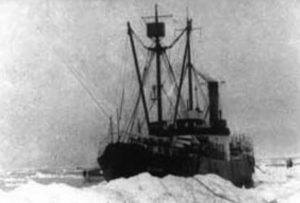 Ghost ships have been a prominent tale of mystery over the years. Many say that seeing a ghost ship is an omen of doom, which I do not believe in, nor do I believe in ghosts or ghost ships, but there was a ship that was dubbed a ghost ship, and has had the longest standing as a possible ghost ship in history, at least to my knowledge. The SS Baychimo was a cargo ship that was built in 1914 in Sweden. It was used for trading routes between Hamburg and Sweden. After World War I, the ship was sold to the Hudson’s Bay Company. The ship made numerous sailings for Hudson’s, mostly carrying cargo to and from the Arctic region.
Ghost ships have been a prominent tale of mystery over the years. Many say that seeing a ghost ship is an omen of doom, which I do not believe in, nor do I believe in ghosts or ghost ships, but there was a ship that was dubbed a ghost ship, and has had the longest standing as a possible ghost ship in history, at least to my knowledge. The SS Baychimo was a cargo ship that was built in 1914 in Sweden. It was used for trading routes between Hamburg and Sweden. After World War I, the ship was sold to the Hudson’s Bay Company. The ship made numerous sailings for Hudson’s, mostly carrying cargo to and from the Arctic region.
The Baychimo had a lucrative career until October 1, 1931, when it was on a routine voyage, filled with recently acquired furs. An unexpected storm blew in, trapping the ship in a sea filled with ice. The closest city was Barrow, Alaska, the northern most city in the United States, and almost like being on top of the world, but it was too far to get to in the blowing snow and high winds. The captain and crew had to stay inside the trapped ship, where they hoped to wait out the storm. This storm was the beginning of the more bizarre part of Baychimo’s life.
When October 15th rolled around, the ship could still be found stuck in the ice, so 15 of the crew members were airlifted to safety. The captain and 14 other crew members made a temporary camp on the ice near the stranded ship…which turned out to be a very wise decision. The terrible weather continued to pound the crew and the “temporary” camp became home for weeks. Then, on November 24th, a fierce blizzard hit the area, and the snow was so heavy that the campers could no longer see the Baychimo, which was still trapped in the ice…or so they thought. The next morning, it was just as the expected. The ship had vanished. They assumed that it had been sunk by the preceding blizzard. The remaining crew made their way back to civilization.
Then, less than a week later, a hunter told the captain that the Baychimo could not have sunk, as he had just seen it floating in the icy waters almost fifty miles from the location where it had been abandoned. The captain was, understandably reluctant to battle the snows to try and find the ship, knowing that it could be miles for the last known location. Nevertheless, he gathered his crew and went looking. Just as the hunter had said, they found the Baychimo in the location the hunter had described. The ship looked like it was no longer seaworthy, so the captain didn’t think it would stay afloat much longer and would soon break apart and sink, so the crew gathered the cargo of furs and had everything, including the captain and the crew, airlifted out of the area.
The captain was wrong. The SS Baychimo was spotted again and again. In March of 1933, some Eskimos, trapped by a storm, took shelter in the Baychimo for a week until the weather improved enough to journey back to their homes. In November of 1939, another ship came close enough to the Baychimo that they were 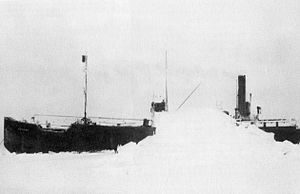 able to board the abandoned ship, but due to the approaching ice floes, the captain did not have the time to bring it back to a port, although he did report the empty ship’s location. In 1969, the Baychimo was spotted at a distance, once again trapped in an ice pack. This was the last recorded sighting of the ship, and after a few years it was commonly believed that the ship did eventually give in to its deteriorating condition and sank to the bottom of the frigid seas. Not everyone agreed though, because in 2006, seventy-five years after the ship was first abandoned, the state of Alaska formally began an effort to find the mysterious SS Baychimo, the Arctic’s elusive wandering ship.
able to board the abandoned ship, but due to the approaching ice floes, the captain did not have the time to bring it back to a port, although he did report the empty ship’s location. In 1969, the Baychimo was spotted at a distance, once again trapped in an ice pack. This was the last recorded sighting of the ship, and after a few years it was commonly believed that the ship did eventually give in to its deteriorating condition and sank to the bottom of the frigid seas. Not everyone agreed though, because in 2006, seventy-five years after the ship was first abandoned, the state of Alaska formally began an effort to find the mysterious SS Baychimo, the Arctic’s elusive wandering ship.
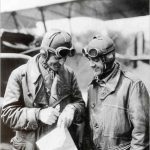 Since people began moving around the world there was a need for mail service, but people hated to wait months to hear from their loved ones…especially if it was with bad news. There had to be a way to get he mail faster and with the invention of the airplane, in late 1903, the possibility of a new way to deliver the mail was on the horizon. It really didn’t take very long for someone to make the metal leap from driving the mail to flying the mail from place to place. Where there is a need, there must be a solution. That solution came on May 15, 1918, when the United States officially established airmail service between New York and Washington DC, using Army aircraft and pilots. Prior to this date, the Post Office Department used new transportation systems such as railroads or steamboats to transport mail. They contracted with the owners of the lines to carry the mail. There were no commercial airlines to contract with, so no one had thought about that yet, but that was about to change.
Since people began moving around the world there was a need for mail service, but people hated to wait months to hear from their loved ones…especially if it was with bad news. There had to be a way to get he mail faster and with the invention of the airplane, in late 1903, the possibility of a new way to deliver the mail was on the horizon. It really didn’t take very long for someone to make the metal leap from driving the mail to flying the mail from place to place. Where there is a need, there must be a solution. That solution came on May 15, 1918, when the United States officially established airmail service between New York and Washington DC, using Army aircraft and pilots. Prior to this date, the Post Office Department used new transportation systems such as railroads or steamboats to transport mail. They contracted with the owners of the lines to carry the mail. There were no commercial airlines to contract with, so no one had thought about that yet, but that was about to change.
Army Major Reuben H. Fleet was charged with setting up the first US airmail service, scheduled to operate beginning May 15, 1918 between Washington DC, Philadelphia, Pennsylvania, and New York City. The army pilots chosen to fly that day were Lieutenants Howard Culver, Torrey Webb, Walter Miller and Stephen Bonsal, all chosen by Major Fleet, and Lieutenants James Edgerton and George Boyle, both chosen by postal officials. Edgerton and Boyle had only recently graduated from the flight school at Ellington Field, Texas and neither had more than 60 hours of piloting time. While I’m sure they were a bit nervous, I’m also sure they were excited to be standing on the threshold of history.
The project got off to a bit of an embarrassingly rocky start, when Lieutenant Boyle, who was engaged to the daughter of Interstate Commerce Commissioner Charles McChord, was selected to pilot the first plane out of Washington DC that day. After all his preparations, Boyle hopped into his plane and was unable to start it. The plane had not been fueled. I’m sure that added a bit of nervousness to the situation. Nevertheless, he finally got his Curtiss Jenny, loaded with 124 pounds of airmail, into the air and made his way to Washington DC. His assignment was to fly to Philadelphia, the mid-way stop between the Washington and New York ends of the service. He did not make it there that day. The novice pilot got lost and low on gas, crash landed in rural Maryland, less than 25 miles away from Washington.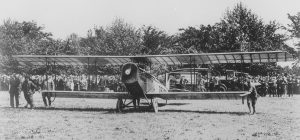
Fortunately for the service, the other flights operated as scheduled that day. Thanks to his political connections, Lieutenant Boyle was given a second chance to fly the airmail out of Washington DC. This time, he was given an escort who flew him out of the city, having given him directions to “follow the Chesapeake Bay” towards Philadelphia. Unfortunately, Boyle followed those instructions too literally, following the curve of the bay over to Maryland’s eastern shore, where he landed, out of fuel again. Not even Boyle’s connections could help him now, and he was removed from the pilots list for the service. I’m sure that didn’t help his standing with his future father-in-law either.
The other rookie pilot, Lieutenant James Edgerton, did much better on his flights and stayed with the service. Edgerton managed to keep his plane aloft during a violent storm that struck while he was on another flight, even as the propeller was pelted by hail. He stayed with the mail service until the next year, and became the Chief of Flying Operations. Then in August, the Post Office Department took over airmail operations with airplanes and civilian pilots of its own. Captain Benjamin Lipsner was named the first superintendent of the U.S. Airmail Service.
The first flight operated by the Post Office Department took off from College Park, Maryland, on August 12, 1918. The destination was New York. Max Miller flew that historic flight. Miller flew the new Curtiss R-4 aircraft. These new planes had more powerful Liberty 400 horsepower engines. Miller was the first pilot hired by the Post Office Department. He died when his plane caught fire and crashed on September 1, 1920. The Post Office Department decided to launch pathfinding flights from New York to Chicago in September 1918. A major obstacle was the Allegheny Mountains, considered by some to be the most dangerous territory on the route. U.S. Airmail Service Superintendent Benjamin Lipsner chose two of his best pilots, Eddie Gardner and Max Miller, for these flights. Eager competitors, Gardner and Miller turned the test into a race. On September 5, 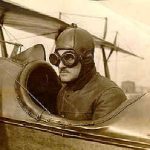 1918, the pair left New York. Miller flew in a Standard airmail plane with a 150-horsepower Hispano-Suiza engine. Gardner followed in a Curtiss R-4 with a 400-horsepower Liberty engine and was accompanied by Eddie Radel, a mechanic. As each pilot landed to refuel or make repairs, he eagerly called Lipsner in Chicago to find out where the other one was. A set of telegrams now in the National Postal Museum tracked their progress. Miller landed in Chicago first, at 6:55 p.m. on September 6. Gardner arrived the next morning, landing at 8:17 at Grant Park. Sometimes it isn’t about the size of the engine I guess. Of course, today, very few people use the postal service, not called “snail mail.” With the internet and texting we have almost instant access to our loved ones.
1918, the pair left New York. Miller flew in a Standard airmail plane with a 150-horsepower Hispano-Suiza engine. Gardner followed in a Curtiss R-4 with a 400-horsepower Liberty engine and was accompanied by Eddie Radel, a mechanic. As each pilot landed to refuel or make repairs, he eagerly called Lipsner in Chicago to find out where the other one was. A set of telegrams now in the National Postal Museum tracked their progress. Miller landed in Chicago first, at 6:55 p.m. on September 6. Gardner arrived the next morning, landing at 8:17 at Grant Park. Sometimes it isn’t about the size of the engine I guess. Of course, today, very few people use the postal service, not called “snail mail.” With the internet and texting we have almost instant access to our loved ones.
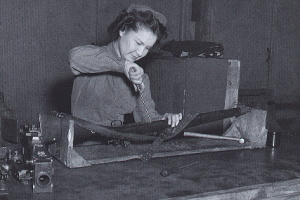
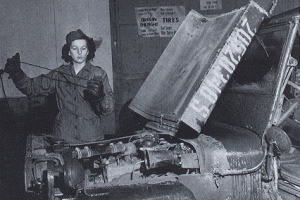 World War II saw many changes in how women were viewed in the normally male-dominated world. With so many men off fighting the war, the women stepped up to do the jobs of riveters in the shipyards, and they stepped up in many other occupations too. If there are no men to do the jobs, someone had to keep the country running, and the United States found out that women were up for the task. I don’t suppose that everyone thought that women could do it, but they simply had no choice. World War II was the largest and most violent armed conflict in the history of mankind. This war taught us, not only about the profession of arms, but also about military preparedness, global strategy, and combined operations in the coalition war against fascism.
World War II saw many changes in how women were viewed in the normally male-dominated world. With so many men off fighting the war, the women stepped up to do the jobs of riveters in the shipyards, and they stepped up in many other occupations too. If there are no men to do the jobs, someone had to keep the country running, and the United States found out that women were up for the task. I don’t suppose that everyone thought that women could do it, but they simply had no choice. World War II was the largest and most violent armed conflict in the history of mankind. This war taught us, not only about the profession of arms, but also about military preparedness, global strategy, and combined operations in the coalition war against fascism.
Prior 1942, the only way for women to be involved in the service was as an Army Nurse, in the Army Nurse Corps, but early in 1941 Congresswoman Edith Nourse Rogers of Massachusetts met with General George C. Marshall, the Army’s Chief of Staff, and told him that she intended to introduce a bill to establish an Army women’s corps, separate and distinct from the existing Army Nurse Corps. Congress approved that bill on May 14, 1942, and the Women’s Army Auxiliary Corps (WAAC) was born. The WAAC bill became law on May 15, 1942. Congressional opposition to the bill centered around southern congressmen. With women in the armed services, one representative asked, “Who will then do the cooking, the washing, the mending, the humble homey tasks to which every woman has devoted herself; who will nurture the children?” These days he would have been run out of Congress for having backward ideas but it was a different time, and one that some women of today truly miss…especially young mothers.
After a long and bitter debate which filled ninety-eight columns in the Congressional Record, the bill finally passed the House 249 to 86. The Senate approved the bill 38 to 27 on May 14. When President Franklin D. Roosevelt signed the bill into law the next day, he set a recruitment goal of 25,000 for the first year. WAAC recruitment topped that goal by November of 1942, at which point Secretary of War Henry L. Stimson authorized WAAC enrollment at 150,000, the original ceiling set by Congress. The day the bill became law, Stimson appointed Oveta Culp Hobby as Director of the WAAC. As chief of the Women’s Interest Section in the Public Relations Bureau at the War Department, Hobby had helped shepherd the WAAC bill through Congress. She had impressed both the media and the public when she testified in favor of the WAAC bill in January. In the words of the Washington Times Herald, “Mrs. Hobby has proved that a competent, efficient woman who works longer days than the sun does not need to look like the popular idea of a competent, efficient woman.” Women would go on to not only become competent and efficient, but requested…sometimes above the men!!
So, what led to the Army’s decision to enlist women during World War II? The answer is simple. The “unfathomable” became reality, as the Army struggled to fulfill wartime quotas from an ever-shrinking pool of candidates. By mid-1943, the Army was simply running out of eligible white men to enlist. The Army could scarcely spare those men already in the service for non-combatant duties. General Dwight D. Eisenhower remarked: “The simple headquarters of a Grant or Lee were gone forever. An Army of filing clerks, stenographers, office managers, telephone operators, and chauffeurs had become essential, and it was scarcely 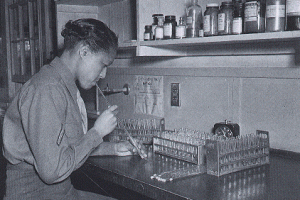
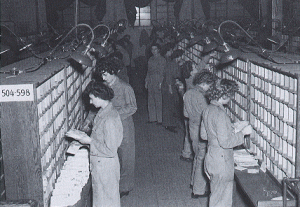 less than criminal to recruit these from needed manpower when great numbers of highly qualified women were available.” While women played a vital role in the success of World War II, their admission into combat roles would not come for many years, and many weren’t sure it was a good idea when it did. The WAC, as a branch of the service, was disbanded in 1978 and all female units were integrated with male units.
less than criminal to recruit these from needed manpower when great numbers of highly qualified women were available.” While women played a vital role in the success of World War II, their admission into combat roles would not come for many years, and many weren’t sure it was a good idea when it did. The WAC, as a branch of the service, was disbanded in 1978 and all female units were integrated with male units.

